Difference between revisions of "Philadelphia"
| Line 53: | Line 53: | ||
===Physical Geography=== | ===Physical Geography=== | ||
| + | |||
| + | Philadelphia sits astride the east and west bank of the River Cerisa in the Province of Oceania on the island of New Australia in the Azazian Archipelago. As the river empties into the Pacific Ocean it discharges approximately 2,400 m³/s and so flows rather slowly, an advantage that renders the massive harbour and bay of Philadelphia silted at a rate that can be dealt with modern dredging technology. | ||
| + | |||
| + | To the east of the city lay the Oceania Range, formed by the collision of the Belden Continental Plate into the Azazian Plate, the former laying to the east of the Brittany Strait while Philadelphia lay upon the Azazian Plate with the Oceania Range. The foothills of the Oceania Range extend almost the length of the New Australian Coast until they reach the River Cerisa, where they wind down to flat plains that stretch from the river on into the central and western regions of the island. For Philadelphia, this creates a narrow stretch of land along the eastern bank of the river while to the west lay kilometers of open land. It is the eastern bank where most of the city’s high-end services are located and the western bank where most of the city’s population resides. | ||
===Climate=== | ===Climate=== | ||
| + | |||
| + | {| border=1 cellpadding=4 cellspacing=0 class="toccolours" style="float: left; width: 20%; clear: both; margin: 1em 1em 1em 1em; border-style: solid; border:1px solid #7f7f7f; border-right-width: 2px; border-bottom-width: 2px; border-collapse: collapse; font-size: 95%;" | ||
| + | |+ | ||
| + | |- | ||
| + | ! colspan=2 | http://img.photobucket.com/albums/v318/fbcatholicsfan/ClimographinRedandGreen.jpg <br/> Climograph of Philadelphia | ||
| + | |} | ||
| + | |||
| + | The Philadelphia region falls under the designation of a tropical wet and dry climate according to the [[Wikipedia:Climate_zone|Köppen Climate Classification System]]. Temperatures remain relatively constant, hovering between 25 and 30 degrees Celsius while precipitation comes in a wet and a dry season with the most precipitation falling in the winter months near January while the months of June, July, and August often sees under 2 centimeters of precipitation. | ||
| + | |||
| + | Precipitation does occur nearly everyday, however, as the climate is governed by a Pacific [[Wikipedia:anticyclone|anticyclone]], a subtropical high-pressure system that generates relatively stable weather blown in from the prevailing trade winds that run from the northeast to the southwest. Although the high pressure systems carry little water, the fact that it exists over the warm Pacific north of the Azazian Archipelago means that these winds do carry some precipitation, an amount sufficient enough to ensure that the Philadelphia region receives light, and brief, rain showers almost everyday. A side effect of this is that the skies above Philadelphia, while often free of rain clouds, are almost never cloud-free although they remain a vibrant blue. | ||
| + | |||
| + | During the winter months, however, as the subtropical high moves to the south, the influence of low-pressure systems and accompanying cold fronts can bring major storm systems across the archipelago, most often from west to east or southwest to northeast – and with Philadelphia located to the windward side of the Oceania Range the precipitation is increased through the [[Wikipedia:Orthographic_lifting_effect|orthographic process]]. It is these winter months that see the most severe weather in Philadelphia, although even in these storm systems lightening and thunder are often infrequent and the storms consist mostly of torrential downpours and bursts of high winds. | ||
===Environmental Issues=== | ===Environmental Issues=== | ||
| + | |||
| + | Philadelphia leads the United Kingdom in its attempts to develop an interface between urban development and the environment that conserves and preserves the city’s natural beauty. The city makes use of an extensive network of mass-transit systems from high-speed, high-capacity light rail systems to ferries and busses, the majority of which are now powered by low-emission hybrid engines. However, the substantial size of the city’s population equates into a still significant environmental footprint in the area of air and water pollution. | ||
| + | |||
| + | The natural advantage of Philadelphia is that the prevailing trade winds push most of the air pollution away from the landmass while the Oceania Range’s windward face collects most of the pollution transported from New Britain and other islands to the north and east. Of more immediate concern, however, is the consumption of water resources. | ||
| + | |||
| + | {| border=1 cellpadding=4 cellspacing=0 class="toccolours" style="float: left; width: 20%; clear: both; margin: 1em 1em 1em 1em; border-style: solid; border:1px solid #7f7f7f; border-right-width: 2px; border-bottom-width: 2px; border-collapse: collapse; font-size: 95%;" | ||
| + | |+ | ||
| + | |- | ||
| + | ! colspan=2 | http://img.photobucket.com/albums/v318/fbcatholicsfan/DesalinisationPlant.jpg <br/> The interior of a desalinisation plant outside Philadelphia | ||
| + | |} | ||
| + | |||
| + | Although much of the city can draw from the relatively unpolluted River Cerisa, there remain millions of citizens who must pay for water imported from mountains and aquifers located throughout New Australia – requiring an expansive water transportation infrastructure system that itself leaves an environmental footprint. Urban dwellers, both businesses and denizens alike, have also attempted to make water more accessible and many newer constructions utilise rain-catchments on their roofs that feed water into the city’s main treatment system. Through the use of meters and registers, the individual owning the property who collects rainwater for the city’s use receives a proportional discount on the price of clean water he or she uses from the city’s water system. | ||
| + | |||
| + | The other solution for the water shortage are the eight massive desalinization plants along the coast of Oceania that produce enough drinking water to cover the province’s shortcomings and enough to export to the northern province of West Oceania. However, the desalinization plants produce a hypersaline brine as a byproduct of the creation of fresh water, a substance that must be disposed of or it can cause significant damage to especially marine environments. Indeed, a coral reef off the coast of New Australia has already lost significant portions of its natural biodiversity as a result of the careless dumping of the brine into the ocean, which carried it south and to the west to the coral reef. Since this discovery, Parliament has enacted strict measures regarding the disposal of desalinization byproducts but the effects of years of misuse will remain for decades to come. | ||
==Government== | ==Government== | ||
==Economy== | ==Economy== | ||
| + | |||
| + | {| border=1 cellpadding=4 cellspacing=0 class="toccolours" style="float: left; width: 20%; clear: both; margin: 1em 1em 1em 1em; border-style: solid; border:1px solid #7f7f7f; border-right-width: 2px; border-bottom-width: 2px; border-collapse: collapse; font-size: 95%;" | ||
| + | |+ | ||
| + | |- | ||
| + | ! colspan=2 | http://img.photobucket.com/albums/v318/fbcatholicsfan/FinancialSector.jpg <br/> Looking Towards the Financial District | ||
| + | |} | ||
| + | |||
| + | Philadelphia is the business and commercial capital of the United Kingdom with the financial, insurance, real estate, and creative industries as the backbone of the city’s economic power. In the past, manufacturing and the mining of iron and coal once played an important role although in recent decades these industries have been on a decline. | ||
| + | |||
| + | Although the Philadelphia Exchange (PHEX) ranks second to that of the Barent Exchange it should be noted that the two exchanges feature two different sectors of the UK economy with the Barent exchange holding the nation’s primary industrial and resource-based corporations while the PHEX lists most of the UK’s service industry goods – and as the UK’s manufacturing industry continues to decline the PHEX is expected to surpass the Barent Exchange permanently within the next five years. | ||
| + | |||
| + | The financial sector of the city serves not only the whole of the United Kingdom but also functions as the UK’s primary financial interface with the world markets with many of the UK’s main internationally-focused banks and credit companies headquartered in the city. In coming years, as the UK slowly opens itself up to the international market the city can be expected to grow as a home to international businesses – especially in the financial sector. | ||
| + | |||
| + | The service industries, including science research companies and medical laboratories, have also flocked to the city because of its status as the nation’s leading internet gateway, the main terminus for many fiber-optic cable trunks connecting the United Kingdom to the rest of the world. Especially making use of this unique position are numerous software and game-design firms that utilise the excellent data-transfer rates to connect to their offices in foreign countries or even to sell their product overseas. | ||
| + | |||
| + | {| border=1 cellpadding=4 cellspacing=0 class="toccolours" style="float: right; width: 20%; clear: both; margin: 1em 1em 1em 1em; border-style: solid; border:1px solid #7f7f7f; border-right-width: 2px; border-bottom-width: 2px; border-collapse: collapse; font-size: 95%;" | ||
| + | |+ | ||
| + | |- | ||
| + | ! colspan=2 | http://img.photobucket.com/albums/v318/fbcatholicsfan/PortofPhiladelphia-small.jpg <br/> Port of Philadelphia | ||
| + | |} | ||
| + | The Port of Philadelphia remains one of the city’s most invaluable assets. As the River Cerisa empties into the Pacific Ocean, it widens rapidly and while silt does tend to build up in the deep natural channel the city frequently dredges the harbour to both keep the port at maximum capacity as well as to add land to the southern coast of the city, allowing for a slow, but continual growth of the city’s borders. The estimated total tonnage of shipping estimated to flow into the Port of Philadelphia in 2005 comes in at nearly 2.25 billion gross tons, only Breningrad comes close at 1.9 billion gross tons estimated for the year 2005. | ||
| + | |||
| + | To the north and west of the port lay the city’s many industrial zones, which although in decline in recent years, still provide the United Kingdom with millions of tons of consumer goods and most importantly specialized manufacturing especially in the areas of shipbuilding. Although headquartered in Breningrad, Breningrad Shipyards Merchant Division operates nearly thirty drydocks along the harbour for the construction of civilian merchant ships from container vessels to ultra-large oil and natural gas vessels. In a telling sign of the city’s importance in shipbuilding, although it remains second to Breningrad, the nation’s number two shipbuilder, Carson and Wolff also operates just over twenty drydocks for the construction of civilian merchant vessels and naval warships. | ||
==Demographics== | ==Demographics== | ||
| Line 93: | Line 146: | ||
*Loviz, [[Novikov|Royal Crown Colony of Novikov]] (formerly the independent state of Novikov) | *Loviz, [[Novikov|Royal Crown Colony of Novikov]] (formerly the independent state of Novikov) | ||
| + | *[[Timiocato]], [[Pacitalia]] | ||
Revision as of 02:05, 3 February 2006
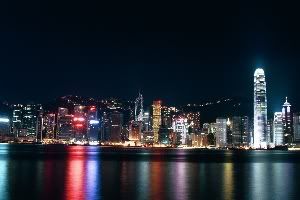
| |
|---|---|
| Motto Philadelphia, Where the World Comes Alive | |
| Population | 52,745,103 |
| District(s) | Aberdeen Charleston |
| County | Aberdeen |
| Republic | Bennington |
| Country | United Kingdom of Azazia |
| Post Town | Philadelphia |
| Postal Code | PH, PE, PW, AB, CK, DO |
| Parliament District | Aberdeen Charleston |
Philadelphia is largest city in the Republic of Bennington, and the second-largest in the United Kingdom with a population of over 52 million in the immediate environs, and 87 million including the surrounding metropolitan area. Once the so-called capital of the American colony in the United Kingdom, the city has become one of the UK’s leading financial and cultural centres that is blossoming into a truly world city.
Ranked as the No. 1 “Most Livable City in the United Kingdom” in the 2005 edition of the annual Urban Review, Philadelphia enjoys a temperate climate, white sand beaches and a coastline that glitters with glass and gold.
Contents
History
Geography
Physical Geography
Philadelphia sits astride the east and west bank of the River Cerisa in the Province of Oceania on the island of New Australia in the Azazian Archipelago. As the river empties into the Pacific Ocean it discharges approximately 2,400 m³/s and so flows rather slowly, an advantage that renders the massive harbour and bay of Philadelphia silted at a rate that can be dealt with modern dredging technology.
To the east of the city lay the Oceania Range, formed by the collision of the Belden Continental Plate into the Azazian Plate, the former laying to the east of the Brittany Strait while Philadelphia lay upon the Azazian Plate with the Oceania Range. The foothills of the Oceania Range extend almost the length of the New Australian Coast until they reach the River Cerisa, where they wind down to flat plains that stretch from the river on into the central and western regions of the island. For Philadelphia, this creates a narrow stretch of land along the eastern bank of the river while to the west lay kilometers of open land. It is the eastern bank where most of the city’s high-end services are located and the western bank where most of the city’s population resides.
Climate
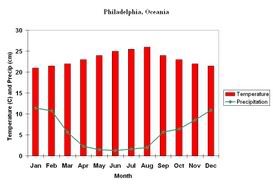 Climograph of Philadelphia |
|---|
The Philadelphia region falls under the designation of a tropical wet and dry climate according to the Köppen Climate Classification System. Temperatures remain relatively constant, hovering between 25 and 30 degrees Celsius while precipitation comes in a wet and a dry season with the most precipitation falling in the winter months near January while the months of June, July, and August often sees under 2 centimeters of precipitation.
Precipitation does occur nearly everyday, however, as the climate is governed by a Pacific anticyclone, a subtropical high-pressure system that generates relatively stable weather blown in from the prevailing trade winds that run from the northeast to the southwest. Although the high pressure systems carry little water, the fact that it exists over the warm Pacific north of the Azazian Archipelago means that these winds do carry some precipitation, an amount sufficient enough to ensure that the Philadelphia region receives light, and brief, rain showers almost everyday. A side effect of this is that the skies above Philadelphia, while often free of rain clouds, are almost never cloud-free although they remain a vibrant blue.
During the winter months, however, as the subtropical high moves to the south, the influence of low-pressure systems and accompanying cold fronts can bring major storm systems across the archipelago, most often from west to east or southwest to northeast – and with Philadelphia located to the windward side of the Oceania Range the precipitation is increased through the orthographic process. It is these winter months that see the most severe weather in Philadelphia, although even in these storm systems lightening and thunder are often infrequent and the storms consist mostly of torrential downpours and bursts of high winds.
Environmental Issues
Philadelphia leads the United Kingdom in its attempts to develop an interface between urban development and the environment that conserves and preserves the city’s natural beauty. The city makes use of an extensive network of mass-transit systems from high-speed, high-capacity light rail systems to ferries and busses, the majority of which are now powered by low-emission hybrid engines. However, the substantial size of the city’s population equates into a still significant environmental footprint in the area of air and water pollution.
The natural advantage of Philadelphia is that the prevailing trade winds push most of the air pollution away from the landmass while the Oceania Range’s windward face collects most of the pollution transported from New Britain and other islands to the north and east. Of more immediate concern, however, is the consumption of water resources.
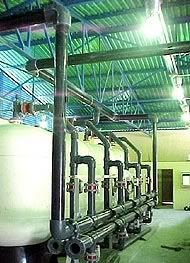 The interior of a desalinisation plant outside Philadelphia |
|---|
Although much of the city can draw from the relatively unpolluted River Cerisa, there remain millions of citizens who must pay for water imported from mountains and aquifers located throughout New Australia – requiring an expansive water transportation infrastructure system that itself leaves an environmental footprint. Urban dwellers, both businesses and denizens alike, have also attempted to make water more accessible and many newer constructions utilise rain-catchments on their roofs that feed water into the city’s main treatment system. Through the use of meters and registers, the individual owning the property who collects rainwater for the city’s use receives a proportional discount on the price of clean water he or she uses from the city’s water system.
The other solution for the water shortage are the eight massive desalinization plants along the coast of Oceania that produce enough drinking water to cover the province’s shortcomings and enough to export to the northern province of West Oceania. However, the desalinization plants produce a hypersaline brine as a byproduct of the creation of fresh water, a substance that must be disposed of or it can cause significant damage to especially marine environments. Indeed, a coral reef off the coast of New Australia has already lost significant portions of its natural biodiversity as a result of the careless dumping of the brine into the ocean, which carried it south and to the west to the coral reef. Since this discovery, Parliament has enacted strict measures regarding the disposal of desalinization byproducts but the effects of years of misuse will remain for decades to come.
Government
Economy
 Looking Towards the Financial District |
|---|
Philadelphia is the business and commercial capital of the United Kingdom with the financial, insurance, real estate, and creative industries as the backbone of the city’s economic power. In the past, manufacturing and the mining of iron and coal once played an important role although in recent decades these industries have been on a decline.
Although the Philadelphia Exchange (PHEX) ranks second to that of the Barent Exchange it should be noted that the two exchanges feature two different sectors of the UK economy with the Barent exchange holding the nation’s primary industrial and resource-based corporations while the PHEX lists most of the UK’s service industry goods – and as the UK’s manufacturing industry continues to decline the PHEX is expected to surpass the Barent Exchange permanently within the next five years.
The financial sector of the city serves not only the whole of the United Kingdom but also functions as the UK’s primary financial interface with the world markets with many of the UK’s main internationally-focused banks and credit companies headquartered in the city. In coming years, as the UK slowly opens itself up to the international market the city can be expected to grow as a home to international businesses – especially in the financial sector.
The service industries, including science research companies and medical laboratories, have also flocked to the city because of its status as the nation’s leading internet gateway, the main terminus for many fiber-optic cable trunks connecting the United Kingdom to the rest of the world. Especially making use of this unique position are numerous software and game-design firms that utilise the excellent data-transfer rates to connect to their offices in foreign countries or even to sell their product overseas.
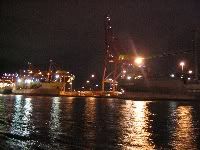 Port of Philadelphia |
|---|
The Port of Philadelphia remains one of the city’s most invaluable assets. As the River Cerisa empties into the Pacific Ocean, it widens rapidly and while silt does tend to build up in the deep natural channel the city frequently dredges the harbour to both keep the port at maximum capacity as well as to add land to the southern coast of the city, allowing for a slow, but continual growth of the city’s borders. The estimated total tonnage of shipping estimated to flow into the Port of Philadelphia in 2005 comes in at nearly 2.25 billion gross tons, only Breningrad comes close at 1.9 billion gross tons estimated for the year 2005.
To the north and west of the port lay the city’s many industrial zones, which although in decline in recent years, still provide the United Kingdom with millions of tons of consumer goods and most importantly specialized manufacturing especially in the areas of shipbuilding. Although headquartered in Breningrad, Breningrad Shipyards Merchant Division operates nearly thirty drydocks along the harbour for the construction of civilian merchant ships from container vessels to ultra-large oil and natural gas vessels. In a telling sign of the city’s importance in shipbuilding, although it remains second to Breningrad, the nation’s number two shipbuilder, Carson and Wolff also operates just over twenty drydocks for the construction of civilian merchant vessels and naval warships.
Demographics
Culture
Transportation and Infrastructure
Home to one of the largest inter- and intra-urban transportation systems in the United Kingdom, if not the world, the city of Philadelphia has attempted in the past several years to steadily decrease its dependence upon personal automobiles. The older sections of the city, primarily the central business district, have few areas left in which they can expand their infrastructure for automobiles, i.e. more roads, double- and triple-decked highways and so the city has implemented a plan to charge tolls on the most heavily traveled roads within the city’s most congested cores.
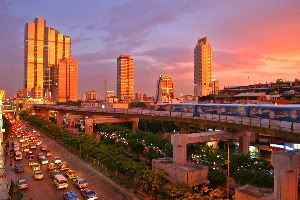 Sky-Rail Headed Towards the Aberdeen District |
|---|
According to the city’s Transportation White Paper (2003), the fares collected will help finance a major plan to re-design and re-vitalise the city’s mass transit system with higher capacity systems primarily of the light-rail variety. With nearly five hundred kilometers of light rail tracks already laid in the city, primarily underground, expansion is set to occur above city streets. The White Paper of 2003 called for the establishment of a radial system that would carry passengers into and out of the central cores of Philadelphia at an extremely fast, but safe, rate of speed.
Not all of the city’s needs, however, can be met by simple rail and road plans for as one travels south the city is slowly split ever further apart by the Bay of Philadelphia, which hosts His Majesty’s Station Philadelphia as well as the busy Port of Philadelphia. To the north of the bay near the mouth of the River Cerisa the Norman Baker Bridge, a combined railway-road bridge that utilises a self-anchored suspension design for its main span, was opened in early 2005 to replace an aging causeway that had to that time hindered the transit of larger ocean-going freighters and tankers further upriver to the heart of Philadelphia.
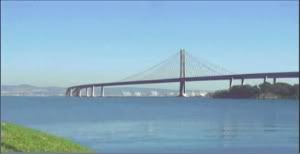 Norman Baker Bridge Crossing the Bay of Philadelphia |
|---|
Yet, the need of the Royal Navy to operate its massive warships in the bay require tunnels to be built under the sea bed in conjunction with dozens of ferry ports for cheap connections to reach the two sides of the city. In the late 1990s the city privatized the ferry companies and tunnel operators as part of Parliament’s sweeping economic reforms that sought to bring new life into stagnant industries. And while crossing the Bay still requires a significant amount of time, the new tunnels, bridges, and ferry routes greatly alleviate the prior headaches of long commuters or vacation sojourns.
Lastly, Philadelphia-based companies operate five major airports, eleven regional airports, and fourteen heliports that handle upwards of 200 million persons per year, cementing the city as the transportation hub for the eastern United Kingdom. With the enormous distances to be traveled between the Azazian Archipelago and the nearest continent, air travel has been for decades the fastest means of travel on an international level. However, with the advent of the personal plane in 2002 by the Chesterbrook Aviation Ltd., average citizens can fly cheaply on small-scale airlines that perform island hopping services to the UK’s hundreds of islands, and those without airports are made accessible by helicopter ensuring that the whole of the United Kingdom is within reach. And from Philadelphia the ability to reach the UK and the world is merged into true convenience.
Sister Cities
- Loviz, Royal Crown Colony of Novikov (formerly the independent state of Novikov)
- Timiocato, Pacitalia
